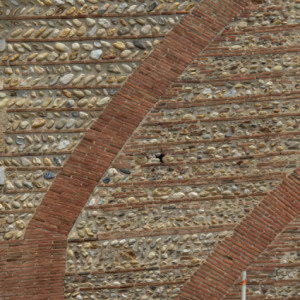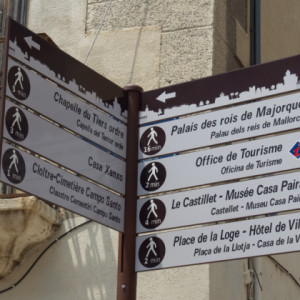Sense of place
I'm back on the road or, more accurately, the train tracks. Just a short journey today, to Perpignan.
I felt a dissonance as soon as I left the bright shiny station - a big contrast with the road to the centre of town: empty shops, lots of cigarette smoke, people asking for €5 'to get home', pawn shops, the density of cheap takeaways with حلال on their signs, a feeling of lassitude...
My discomfort persisted despite the friendly tourist office staff, the photogenic faded paint on walls and shutters, the beautiful buildings made from diagonal stones separated by long thin red bricks (extra), and the many other touristy things there are to see, all of them welcoming and, unusually, either free or cheap. I looked at the imposing facade of the Hotel de Ville, dragged my feet round the huge red-brick Castillet - once a gate into the city and later a prison - and I drooped round the splendid art nouveau Hotel Pams built on cigarette-paper money. I visited the cathedral and sat despondent in the cloisters trying to generate some energy. Then it occurred to me to look at other blippers' takes on Perpignan. As soon as I saw a comment about the Arab quarter being unsafe I was on my feet again. That's how I can understand a place - by knowing why other people are wary about it. In minutes I was walking into a disgracefully neglected area of town (extra). Its market, unsubtly dominated by the Direction Départementale de la Sécurité Publique, was closed. Ah, of course - Ramadan. Perhaps that's partly why I was picking up on a city short of energy. (Edit - excellent commentary by Veronica on the state of Perpignan here.)
I rebooted myself and walked half-way round the massive fortifications to the entrance of the 13th century Palais des Rois de Majorque/Palau dels Reis de Mallorca. Oh fabulous! Inside, its medieval proportions are heartlifting. The courtyard is large enough for the steps up to the arched balcony and the chapel to be elegantly shallow. In the great hall I sat in a deep stone window-seat to grin happily at the four layers of arches in the end wall, each spreading the weight to put less pressure on the three huge hearth arches at the bottom. (A carousel of pictures on the right of this page). I loved it all, even standing at the top of the tower looking out over the city, the plain and the wind turbines, watching the rain pouring over Canigou and heading our way, knowing I didn't have my waterproof jacket with me.
I meandered back into the centre under big floppy raindrops, breathing in the smell of wet dust, and completely unexpectedly found myself outside the Musée d'Art Hyacinthe Rigaud, which I'd vaguely thought I might visit tomorrow. Being ignorant, I wondered optimistically whether we were talking about a female artist here. Fool.
The gallery is closed on Mondays through winter and spring and as no-one seemed to have noticed that today is the first Monday of June I was the only visitor there. One warder was clearly deputed to keep a discreet eye on me and I kept finding her in the rooms I was walking into, looking nonchalant - she must have been scuttling along back-routes through the two large houses that now make up the gallery. After a bit I felt I was in one of those incomprehensible dreamlike 1970s French films. Anyway, gothic religious art: pleasing; Baroque art: yawn; Raoul Dufy: good; Hyacinthe Rigaud: er well. And the apparent highlight of the collection, a 1489 altarpiece, meh. Sorry.
Another extra of a signposting style I've never seen before. The signposts don't point in the direction you need to walk in: you have to look for the arrow and the direction of the walking figure. Very confusing.
Edit on 4 June
I have had an interesting and thought-provoking 24 hours in Perpignan. I was staying in a private home in a 'respectable' working class area on the opposite side of the station from the tourist area. Christine, my host, was very surprised that a woman of my age (she asked!) was travelling alone with a backpack and she was anxious to make my stay comfortable and quiet, to the extent that I heard her this morning (4 June) angrily telling someone in another room that this was a private house and he should turn the music down. She then came to check with me that I hadn't been disturbed by his music or his late return home last night. Clearly what I say about her is more important than what he says.
When I left this morning I decided not to hoik my backpack to the pedestrianised bit of Perpignan, but to have enough time at the station to follow up on its seriously weird Dali connection. He wrote (the translation from Spanish is mine and corrections are welcome - though I think the odd mixture of tenses is accurate) about a vision he had at the station in 1963:
"It's always at Perpignan station that I've had the most brilliant ideas of my life. Arriving at Perpignan station is truly the occasion of a mental ejaculation that reaches its greatest and most sublime speculative height. In Perpignan station I felt a sort of cosmogonical ecstasy stronger than ever before. I have an exact vision of how the universe is constituted. The universe, which is one of the most limited things that exists, would be - assuming the same proportions - similar in its structure to Perpignan station."
I must say I quite liked the station, as stations go, but I missed out on the cosmogonical ejaculation and I failed to see 'the third dimension by its superposition of parabolic lenses, as in the eye of a fly'.
My loss.
Two years later, Dali, dressed as an admiral, made a 'triumphal journey' from Céret in the Pyrenees to Perpignan station to declare it 'El centre del món' (Catalan for 'the centre of the world'), which SNCF now proudly emblazons across the front of the station.
So I was surprised, when I asked after the 'Dali-style' ceiling decorations that had attracted my attention in tourist guides, to be told by an SNCF information official who'd clearly bunked off the visionary section of her induction training, that they had been painted over during station building works but that it didn't matter as 'they were only done by schoolchildren'.
From the sublime to the ridiculous, or possibly vice versa.




Comments
Sign in or get an account to comment.


